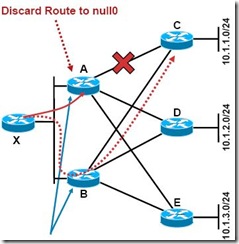Troubleshooting EIGRP
To troubleshoot EIGRP you should obvious have a grasp understanding of the specific routing protocol. Of course this doesn’t only apply to the EIGRP routing protocol.
Troubleshooting the EIGRP routing protocol on a Cisco devices is mainly about logging the correct information to a syslog server, the buffer or the console and know what the output of several show commands mean.
Neighbor instability on a router has mostly one of the following reasons:
- Holding time expired;
- Retry limit exceeded;
- Manual changes like route filter changes;
- Unidirectional links;
- Primary / secondary IP address mismatch (EIGRP uses the primary IP address);
- Routes get Stuck-in-Active aka SIA (“Active” means recovering from a change in the network, for example flapping links). Routes can get SIA by the following reasons: bad or congested links, query range is “too long”, excessive redundancy, overloaded router, router memory shortage and so one;
Many problems with EIGRP appear when using external routes, like redistributing a routing protocol like OSPF into EIGRP. The most common cause of this problem is the absence of setting the metrics. Important when using the redistribute command is specifying the metrics with the default-metric <metric> or redistribute <protocol> metric <metric> command.
Black Hole Summary Routing is also a common problem when using EIGRP. Black Hole Summary Routing is caused when manual summary routes are configured.
The picture shows a case of Black Hole Routing. Routers A and B summary the different /24 networks as one /16 network to router X. Suddenly the link between router A and router C gets lost. Because we used summarization between router A and router X, router X isn’t aware of the lost link, so router X keeps sending traffic for network 10.1.1.0/24 to router A and router B ((un)equal cost load-balancing). All traffic send to router A would get lost in the process.
A solution to this problem is connecting routers A and B by using a physical link or creating a GRE tunnel between both, if the physical links isn’t possible.
As mentioned before, troubleshooting the routing protocol can be done by using the correct show, logging and debug commands. Important commands for troubleshooting EIGRP are:
- show ip eigrp neighbors: for checking neighbors, hold timers, uptime, Smooth Round Trip Timer (SRTT) and Retransmit Time Out (RTO);
- show ip eigrp topology active: used for noticing if route is SIA;
- show ip eigrp events: check what EIGRP events are going on;
- RTR(config-router)#eigrp-log-neighbor-changes;
- RTR(config-router)#logging buffered <size>;
- debug eigrp packet hello: showing the processing of hello packets;
- debug eigrp packet terse: shows all EIGRP packet debugging except hellos;
- debug ip eigrp notifications: troubleshooting redistribution by showing what happens between EIGRP and the routing table as routes are redistributed;
Troubleshooting a routing protocol can only be done if you know what the protocol is actually doing. When troubleshooting it is necessary to know the correct way to troubleshoot and start exempting possibilities for the routing problems. Exempting possibilities narrows the scope, which can result in finding the actual problem.
René Jorissen
Latest posts by René Jorissen (see all)
- MacOS Big Sur and SSLKEYFILELOG - November 23, 2021
- ClearPass, Azure AD, SSO and Object ID - August 12, 2021
- ClearPass – custom MPSK - July 20, 2021
